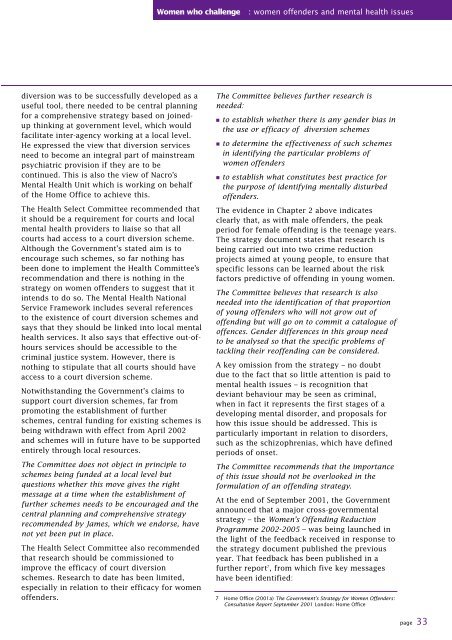Women who challenge - Nacro
Women who challenge - Nacro
Women who challenge - Nacro
- No tags were found...
You also want an ePaper? Increase the reach of your titles
YUMPU automatically turns print PDFs into web optimized ePapers that Google loves.
<strong>Women</strong> <strong>who</strong> <strong>challenge</strong>: women offenders and mental health issuesdiversion was to be successfully developed as auseful tool, there needed to be central planningfor a comprehensive strategy based on joinedupthinking at government level, which wouldfacilitate inter-agency working at a local level.He expressed the view that diversion servicesneed to become an integral part of mainstreampsychiatric provision if they are to becontinued. This is also the view of <strong>Nacro</strong>’sMental Health Unit which is working on behalfof the Home Office to achieve this.The Health Select Committee recommended thatit should be a requirement for courts and localmental health providers to liaise so that allcourts had access to a court diversion scheme.Although the Government’s stated aim is toencourage such schemes, so far nothing hasbeen done to implement the Health Committee’srecommendation and there is nothing in thestrategy on women offenders to suggest that itintends to do so. The Mental Health NationalService Framework includes several referencesto the existence of court diversion schemes andsays that they should be linked into local mentalhealth services. It also says that effective out-ofhoursservices should be accessible to thecriminal justice system. However, there isnothing to stipulate that all courts should haveaccess to a court diversion scheme.Notwithstanding the Government’s claims tosupport court diversion schemes, far frompromoting the establishment of furtherschemes, central funding for existing schemes isbeing withdrawn with effect from April 2002and schemes will in future have to be supportedentirely through local resources.The Committee does not object in principle toschemes being funded at a local level butquestions whether this move gives the rightmessage at a time when the establishment offurther schemes needs to be encouraged and thecentral planning and comprehensive strategyrecommended by James, which we endorse, havenot yet been put in place.The Health Select Committee also recommendedthat research should be commissioned toimprove the efficacy of court diversionschemes. Research to date has been limited,especially in relation to their efficacy for womenoffenders.The Committee believes further research isneeded:• to establish whether there is any gender bias inthe use or efficacy of diversion schemes• to determine the effectiveness of such schemesin identifying the particular problems ofwomen offenders• to establish what constitutes best practice forthe purpose of identifying mentally disturbedoffenders.The evidence in Chapter 2 above indicatesclearly that, as with male offenders, the peakperiod for female offending is the teenage years.The strategy document states that research isbeing carried out into two crime reductionprojects aimed at young people, to ensure thatspecific lessons can be learned about the riskfactors predictive of offending in young women.The Committee believes that research is alsoneeded into the identification of that proportionof young offenders <strong>who</strong> will not grow out ofoffending but will go on to commit a catalogue ofoffences. Gender differences in this group needto be analysed so that the specific problems oftackling their reoffending can be considered.A key omission from the strategy – no doubtdue to the fact that so little attention is paid tomental health issues – is recognition thatdeviant behaviour may be seen as criminal,when in fact it represents the first stages of adeveloping mental disorder, and proposals forhow this issue should be addressed. This isparticularly important in relation to disorders,such as the schizophrenias, which have definedperiods of onset.The Committee recommends that the importanceof this issue should not be overlooked in theformulation of an offending strategy.At the end of September 2001, the Governmentannounced that a major cross-governmentalstrategy – the <strong>Women</strong>’s Offending ReductionProgramme 2002-2005 – was being launched inthe light of the feedback received in response tothe strategy document published the previousyear. That feedback has been published in afurther report 7 , from which five key messageshave been identified:7 Home Office (2001a) The Government’s Strategy for <strong>Women</strong> Offenders:Consultation Report September 2001 London: Home Officepage 33
















